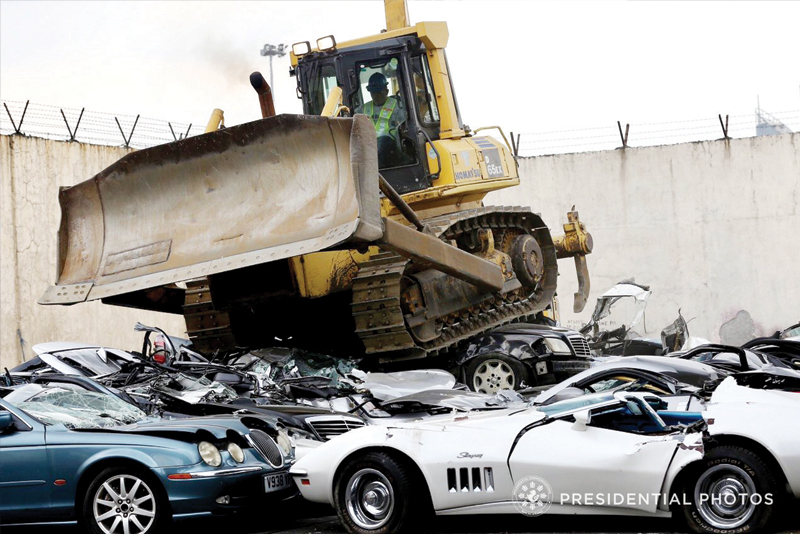Crushed cars crush my heart: How smuggling destroys

A bulldozer ran over luxury vehicles as the destruction of smuggled cars were simultaneously made in the ports of Manila, Davao, Cebu and Subic. Photo courtesy of the Presidential Communications Operations Office
It breaks my heart to see cars get damaged. Even when I watch action movies, i get stressed watching car chases (I get irked by the thought of cars getting dented) and it pains me to see beautiful cars crash, or worse, blow up.
Imagine the heartache I felt when the Bureau of Customs (BOC) destroyed luxury vehicles a week ago. The destruction of vehicles in the Port of Manila was personally overseen by President Rodrigo Duterte. Destruction of other vehicles through a bulldozer were simultaneously conducted in the ports of Subic, Cebu and Davao. The reason for the mass destruction? The vehicles were illegally smuggled.
The vehicles were from various brands and models, with different years and conditions. The smuggled vehicles were mostly in used condition such as a BMW Alpina, Honda Odyssey, Mitsubishi Mini Pajero, Mazda Roadster, Mitsubishi MMC, Toyota SW Towage Noah, Mercedes Benz S550 (2007), Ford Explorer Base 3.5L, Nissan 350Z, Audi S5, Jeep Wrangler (2012), Mercedes Benz CLK 350, Mercedes Benz C280 (1995), BMW 745, BMW 745Li, Audi A6, Hyundai Equus JS350, BMW Z4, Jaguar S-Type, Toyota Tundra, Mercedes Benz (2012), Toyota Land Cruiser, and Mitsubishi Pajero. I was especially sad to see a vintage Corvette Stingray among the list of vehicles that were destroyed.
Brand new vehicles destroyed included a Mercedes Benz, Toyota Land Cruiser L200 and Toyota Land Cruiser V8.
Some of the smuggled vehicles arrived in Philippine ports as far back as 2013 or earlier. Before the smuggled vehicles could be destroyed, “Forfeiture” or “Abandonment” Proceedings were conducted.
Other luxury vehicles that might be destroyed soon include McLaren, Lamborghini and Ferrari sports cars, which are still undergoing litigation according to BOC Deputy Commissioner Edward James Dy Buco.
It seems like a waste to see these vehicles destroyed completely. From having a total value of around P61 million, the scrap metal from theses destroyed cars would only be worth around P48,000 (according to BOC Dep Comm Dy Buco). I thought, wouldn’t it be better to sell these cars and use the revenue for government programs?
The complete destruction of the cars appears to be the more effective way to stop or disincentivize smuggling. Department of Finance Secretary Carlos Dominguez said that if they auction off the cars, the smugglers would be able to bid for them.
What breaks my heart more than seeing cars get crushed by a bulldozer is the realization that smuggling remains to be a problem in the Philippines.
Smuggling is a crime called “unlawful importation” under the Tariff and Customs Code of the Philippines (Tariff Law). When goods or cars are brought to the Philippines, certain requirements and importation documents must be complied with and appropriate taxes must be paid. Car smuggling is committed to evade the payment of taxes and/or to pay cheaper prices compared to their retail prices from authorized distributors. But people who buy smuggled cars fail to see that there is a higher price to pay for smuggled goods.
First of all, the buyer of a smuggled car always takes a high risk of having the car destroyed or confiscated. Under the Tariff Law, smuggled goods shall be forfeited to the Government and can be seized, prosecuted and condemned. Second, the buyer of a smuggled car is also guilty of the crime of unlawful importation. Republic Act No. 4712 (which amended the Tariff Law) identifies people who may commit smuggling: a person who fraudulently imports or brings smuggled goods into the Philippines, anyone who assists such importation, or anyone who shall “receive, conceal, buy, sell, or in any manner facilitates the transportation, concealment or sale” of smuggled goods. The buyer can be subject to fines and penalties including the possibility of imprisonment of up to 12 years. It is difficult to claim good faith after buying a smuggled vehicle. Under the Tariff Law, possession of a smuggled car is “deemed sufficient evidence to authorize conviction, unless the defendant shall explain the possession to the satisfaction of the court.” Having to face a criminal case in court is by itself costly financially and emotionally. Finally, smuggling also incurs a high cost detrimental to society.
Filipinos often expect from the government the provision of basic services and facilities (roads, public schools, public hospitals, public parks, etc). The ability of the government to provide quality facilities and services depend on, and are restricted by, the available budget. The government funds its programs for country development mainly through tax collection and other sources of revenue.
When people patronize smuggled cars or participate in smuggling (even as a buyer), they deprive the government the revenues needed to support development programs. Furthermore, legitimate sellers/automobile distributors are also deprived of customers.
The recent destruction of 30 luxury vehicles was a huge loss in value, and it broke my heart to see beautiful cars go to waste. But higher costs to society’s welfare, and bigger heartaches (if I have to witness more destruction of cars) will come if smuggling activities are allowed to proliferate. For people who truly love cars and our country, vehicle smuggling is something that we should fight against. True love for cars should not be blind. The true cost of a smuggled car is high.
- Latest






























